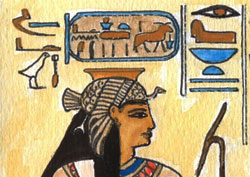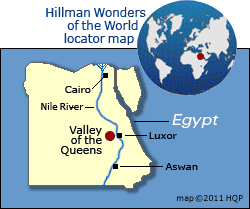Valley of the Queens
 Why the
Valley of the Queens
is special
Why the
Valley of the Queens
is specialThis miniscule barren canyon near Luxor is populated with rock-hewn underground tombs of queens, princes, princesses, and select nobles of the mighty 18th, 19th, and 20th Dynasties of the New Kingdom (lasted 470 years beginning in 1550 BC).
Top 2 Valley of the Queens tombs
Queen Nefertari
The chromatic, prolific, and stunning wall paintings are the chief draw.
Nefertari was the chief wife of Pharaoh Rameses III, was noted for her beauty, and she was one of Ancient Egypt's four most famous queens (Cleopatra, Hatshepsut, and Nefertiti were the other three).
Prince Amon-Khopshef
He was the son of Rameses III and died young. The star attraction is the artwork portraying his father guiding him through the holy funerary process with the gods.
More Valley of the Queens tips & insights
Caveat
The above two Valley of the Queens venues are sometimes closed to the public for long periods (sometimes measuring in years) for restoration or preservation purposes.
Even when officially open, the Nefertari complex strictly limits the number of visitors to reduce the amount of carbon dioxide from human breath (CO2 helps deteriorate the wall art). And visitors must wear provided masks.
Avoid disappointment
Check the latest entrance status of the Nefertari and Amon-Khofshef venues before traveling to the Valley of the Queens. The other 70 or so tombs appeal mainly to archaeology fans. And only a tiny fraction of them is open to the public on a given day.
Location in Egypt



